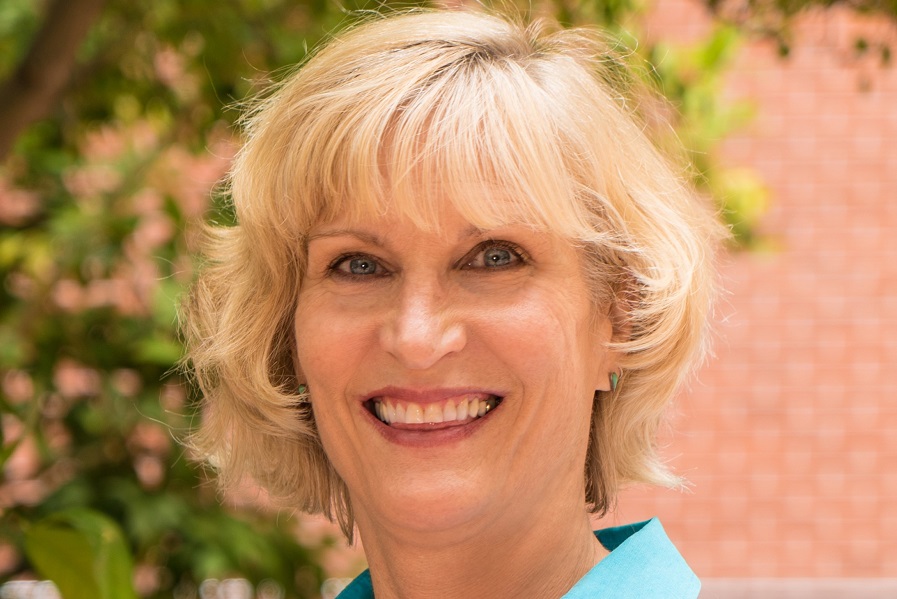UArizona Nursing Professor's Research Earns Her the Nursing Outlook 2020 Excellence in Nursing Education Award
In September, the Nursing Outlook editorial board announced that University of Arizona College of Nursing Clinical Associate Professor Kimberly Shea, PhD, RN, CHPN and co-authors, Barbara Brewer, Jane Carrington, Mary Davis, Sheila Gephart and Anne Rosenfeld were awarded the organization’s 2020 Excellence in Nursing Education Award for their article, "A model to evaluate data science in nursing doctoral curricula." The College of Nursing’s informatics team collaborated to develop and implement this important contribution to the field of nursing education will be recognized in an upcoming issue of Nursing Outlook.
Every year Nursing Outlook, the official journal of the American Academy of Nursing, recognizes the significant contributions of authors to the journal and the nursing profession in the areas of Nursing education, practice, research, and policy. In the winning article, Dr. Shea and her co-authors built on the efforts of the American Association of Colleges of Nursing to develop a model to infuse data science constructs into doctor of philosophy (PhD) curriculum. Using this model, developing nurse scientists will be able to learn data science and be at the forefront of data driven healthcare.
“Data Science needs to be something that we address in every course and is familiar to students because they learn about it over and over again throughout courses, but in different perspectives, so that when they inevitably need to evaluate a large data set for their research question, they are equipped to understand all the dimensions of working with big data," ~ Kimberly Shea, PhD, RN, CHPN
Dr. Shea and her colleagues created the Data Science Curriculum Organizing Model (DSCOM) to guide a comprehensive review of PhD education that will enable data science to be addressed within the individual courses throughout the program. The DSCOM represents concepts and constructs, and their relationships which are essential to a comprehensive understanding of data science. By transforming the terminology and applicability of multidisciplinary data science models into the DSCOM, Dr. Shea’s team found that application of the DSCOM identified areas for threading into core course curriculum, as well as gaps that require additional content. Bottom line: the DSCOM is an effective tool to guide curriculum development and evaluation towards the preparation of nurse scientists with knowledge of data science.
“The ubiquitous presence of technology continually generates vast quantities of data that necessitate leaders within the health care system understand data science,” Dr. Shea and her co-authors wrote in their article. “As the foundation of the health care system, nurses must have a working knowledge of technology generated data. Data science is more than just understanding numbers used for analysis. Data support evidence-based practice and nurse scientists must thoroughly understand the complexities of data science in order to use advanced analysis techniques to build knowledge for providers.”
“In our college we have a remarkable group of informatics scholars and data science is one of the components or interests of informatics,” Dr. Shea explains, noting how retired UArizona Nursing Professor Anne Rosenfeld’s interest in expanding Nursing’s focus on integrating data science into graduate-level curriculum provided the inspiration for the project. “We wanted to see how we might look at integrating data science into our PhD curriculum.”
Dr. Shea and colleagues found that there was ample room for data science to be integrated throughout the College’s courses. “It's not just one course, it's possible within every course,” she says, “because it [data science] applies to every course and every bit of what we teach in today’s [PhD] programs and potentially in the DNP.” However in the article, they only apply the DSCOM to the core courses in the PhD program.
“We decided to use a course mapping technique, taking from all the syllabi and objectives in all of the core courses,” Dr. Shea explains. “We then applied our model to evaluating those syllabi to discover the overlaps and gaps.”
The concept mapping technique was a concerted effort that was painstaking. Dr. Shea says. “In short, we evaluated constructs [Domain, Ethics, Theory, Technical, Analytics and Dissemination] for matches and then gathered information about concepts within the constructs and found that there were opportunities for insertion, overlaps and gaps that needed to be filled.” The course mapping identified that there were 123 matches and 3 large gaps within the existing curriculums.
The next step will be to take what has been learned and implement it into the UArizona Nursing’s upper division course work – and hopefully disseminate use of the model to other nursing schools. Dr. Shea hopes that by sharing the team’s research and conclusions, others will learn the methodology without having to conduct their own intensive evaluations of the academic literature on the subject.
“Ultimately it can be used by nursing colleges and schools throughout the United States and abroad to realize that data science is much bigger than just getting a data set and using statistics” she says, noting that the DSCOM can be accurately used to apply, disseminate, and analyze gaps in the curriculum of other institutions. “It [data science] is our future of evaluating outcomes and needs to be something that we address in every course and is familiar to students because they learn about it over and over again throughout courses, but in different perspectives, so that when they inevitably need to evaluate a large data set for their research question, they are equipped to understand all the dimensions of working with big data.”


